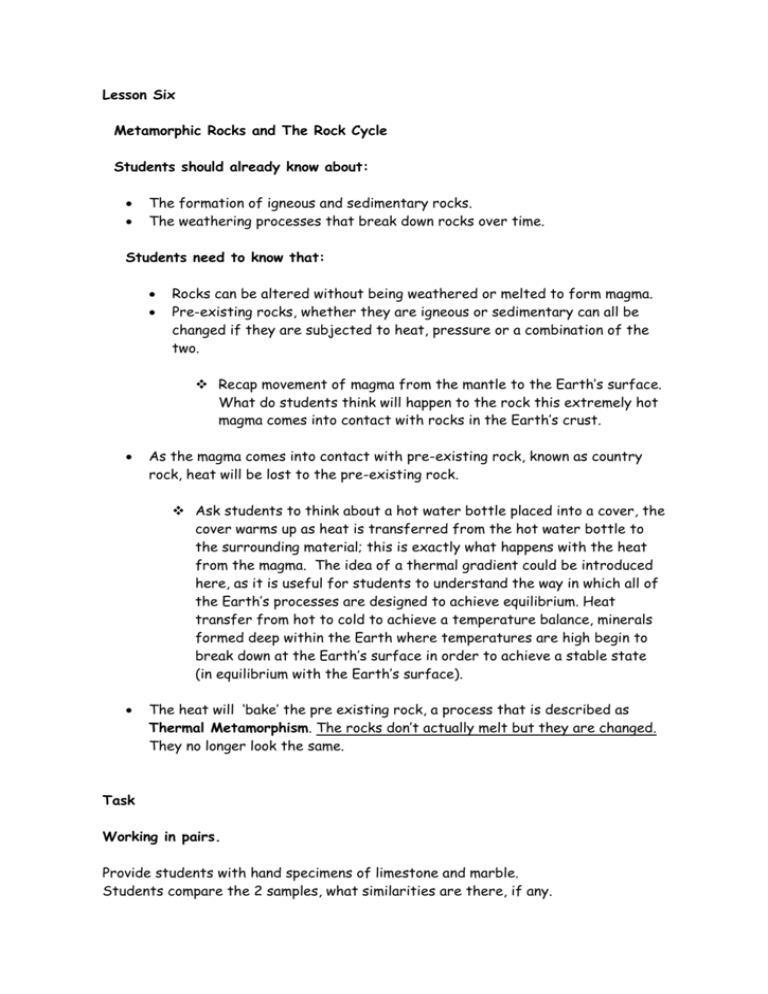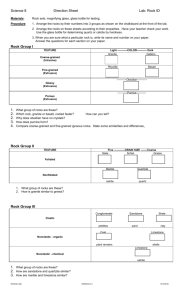Lesson 6 - Virtual Quarry
advertisement

Lesson Six Metamorphic Rocks and The Rock Cycle Students should already know about: The formation of igneous and sedimentary rocks. The weathering processes that break down rocks over time. Students need to know that: Rocks can be altered without being weathered or melted to form magma. Pre-existing rocks, whether they are igneous or sedimentary can all be changed if they are subjected to heat, pressure or a combination of the two. Recap movement of magma from the mantle to the Earth’s surface. What do students think will happen to the rock this extremely hot magma comes into contact with rocks in the Earth’s crust. As the magma comes into contact with pre-existing rock, known as country rock, heat will be lost to the pre-existing rock. Ask students to think about a hot water bottle placed into a cover, the cover warms up as heat is transferred from the hot water bottle to the surrounding material; this is exactly what happens with the heat from the magma. The idea of a thermal gradient could be introduced here, as it is useful for students to understand the way in which all of the Earth’s processes are designed to achieve equilibrium. Heat transfer from hot to cold to achieve a temperature balance, minerals formed deep within the Earth where temperatures are high begin to break down at the Earth’s surface in order to achieve a stable state (in equilibrium with the Earth’s surface). The heat will ‘bake’ the pre existing rock, a process that is described as Thermal Metamorphism. The rocks don’t actually melt but they are changed. They no longer look the same. Task Working in pairs. Provide students with hand specimens of limestone and marble. Students compare the 2 samples, what similarities are there, if any. Wearing goggles students place a few drops of dilute hydrochloric acid on the limestone and note the reaction. The mineral calcite, which is present in limestone, reacts with acid to release the gas carbon dioxide. This is the” fizz” students can see. Student place an equal number of drops of hydrochloric acid on the marble and record the results. What can be deduced from this experiment? Both rocks are made up of calcite yet they don’t look the same. A limestone affected by heat will become a marble. The fossils and calcite crystals in the original limestone alter to become calcite crystals of the same size, which form an interlocking structure. A similar change occurs when quartz rich sandstones are subjected to heat. The rock becomes a mass of interlocking quartz crystals; the new rock is called quartzite. Thermally altered rocks are very strong which is why marble is so often used for carving sculptures. Quartzite is broken into lumps to use as the base on which to mount railway lines. Students need to know that: When mountains are formed great forces are at work pushing up the solid rock. This process generates heat and also pressure, which affects the rocks. The rocks are uplifted to form the mountains and the area around them is affected by heat and pressure. Because these changes take place over such a wide area this type of metamorphism is known as Regional Metamorphism. The pre-existing rocks are changed but do not melt. Task Working in pairs. Give students a selection of mudstones and slates to look at; the mudstones have been changed into the metamorphic rock slate due to the application of heat and pressure. One student describes the mudstone to their partner who takes notes. Roles are reversed and the other member of the pair describes the slate to their partner who takes notes. Students then consider their observations and make a list of the main differences between the two rock samples. Work with the whole class discuss the observations. Mudstones are soft, easily rubbed away with the finger. They are formed of layers but the layers are not easy to see. The slates are brittle, can be snapped (not recommended as a test but something that at least one student is bound to do!). The layers are easily identified; there are sparkly minerals along the layers (mica). Got to http://geologyonline.museum.state.il.us/geogallery/media/images/large/304244.j pg for the images of mica used in Lesson 1. When the original rock is subjected to pressure the flat platy mica minerals align themselves at right angles to the pressure, this makes it easy to split the rock along the boundaries between layers. Ask students to consider what would happen if the mudstone had been subjected to ongoing heat. The rock would melt and become magma – metamorphic rocks have been changed but not melted. Draw the session to a close by recapping on the way in which rocks are formed from a melt, weathered, reformed as a clastic sediment, are formed from organic sources (carbonate rocks) or are affected by heat and pressure and so changed. Draw the outline circle for the Rock Cycle on the board. Use student input to complete the diagram. Encourage students to consider a variety of pathways – sedimentary rock can be weathered to provide the sediments to make a new rock for example, ensure the students recognise that the Rock Cycle is a complex process not simply a circular process. Homework: A storyboard illustrating the Rock Cycle. Your storyboard should be more than just pictures and should include written information about: igneous rocks weathering erosion transportation deposition lithification sedimentary rocks metamorphic rocks. Oxford University Museum of Natural History has a great example of an interactive rock cycle, although designed for younger students it would provide a starting point for students own ideas. Go to http://www.oum.ox.ac.uk/children/rocks/cychome1.htm






